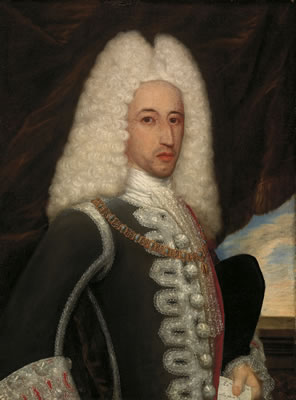Nicolás Fernández de Córdoba, 10th Duke of Medinaceli facts for kids
Quick facts for kids
The Most Excellent
The Duke of Medinaceli
|
|
|---|---|

Portrait by Valero Iriarte, 1729
|
|
| Born | 24 June 1682 Madrid, Spain
|
| Died | 19 March 1739 (aged 56) Madrid, Spain
|
| Nationality | Spanish |
| Occupation | Aristocrat |
Nicolás Fernández de Córdoba y de la Cerda (born June 24, 1682 – died March 19, 1739) was an important Spanish noble. He held the title of the 10th Duke of Medinaceli. He was also a Grandee of Spain, which meant he was one of the highest-ranking nobles in the country. Nicolás served the King of Spain as an Ambassador and held important roles in the queen's household. He was also a knight of the special Order of the Golden Fleece.
Contents
Who Was Nicolás?
Nicolás Fernández de Córdoba y de la Cerda was born in Madrid, Spain, on June 24, 1682. His family was very powerful and wealthy.
His Family Background
Nicolás was the second son of Luis Mauricio Fernández de Córdoba y Figueroa. His father was the 7th Marquis of Priego and the 7th Duke of Feria. His mother was Feliche de la Cerda y Aragón. She was the sister of the 9th Duke of Medinaceli, Luis Francisco de la Cerda.
Nicolás's uncle, Luis Francisco, was the last male from an old branch of the Cerda family. This family descended from Prince Ferdinand de la Cerda, who was the first son of King Alfonso X of Castile. Nicolás had an older brother named Manuel Luis, who died in 1700. When Manuel Luis passed away, Nicolás took over his titles as the 8th Marquis of Priego and 8th Duke of Feria.
His Important Jobs
Before his older brother died, Nicolás started working for the royal family. He was a page for Queen Maria Anna of Neuburg. She was the second wife of King Charles II of Spain. Later, he became a gentleman of the chamber for King Philip V of Spain. This meant he was a close attendant to the king.
Serving the King and Queen
Nicolás took part in some important events for Spain. He was involved in the Battle of Cádiz (1702) and helped defend El Puerto de Santa María.
In 1711, Nicolás became the 10th Duke of Medinaceli. He inherited this title from his uncle, Luis Francisco de la Cerda y Aragón, who had no children. Nicolás decided to move a large library from El Puerto de Santa María to Madrid. This library had been started by Antonio de la Cerda, 7th Duke of Medinaceli. He also moved books from a library in Seville to create one big collection. However, this collection was later sold.
In 1714, King Philip V chose Nicolás's palace as a place to stay after his first wife died. The king then gave Nicolás a very special job. He was made an Ambassador Extraordinary. His task was to take valuable jewels to the new queen, Elisabeth Farnese, in Parma. He also had to officially welcome her on behalf of the king.
Nicolás also served as the queen's Majordomo and Stable master. A Majordomo was the chief officer of a royal household. A Stable master was in charge of the royal stables and horses. On January 10, 1724, King Louis I of Spain honored Nicolás with the Collar of the Fleece. This was a very high award from the Order of the Golden Fleece.
Building and Helping Communities
Nicolás Fernández de Córdoba used his wealth to help many communities. He supported the building of churches, chapels, and prayer places on his lands. On May 7, 1727, he gave permission for the Capuchin Order to set up a monastery in El Puerto de Santa María.
He also ordered the construction of large granaries in Montilla and Aguilar de la Frontera. Granaries are buildings used to store grain. The granary in Montilla was built in 1722 and designed by a famous architect named Juan Antonio Camacho de Saavedra. This same architect might have designed another building for Nicolás in Aguilar, sometimes called the Tercia del Duque. Nicolás died in Madrid on March 19, 1739. He was buried at the Monastery of Santa María de Huerta.
His Family Life
On September 30, 1703, Nicolás married his first cousin, Jerónima María Spínola y de la Cerda. They were married in the San Sebastian Church, Madrid. Jerónima's father was the Marquis of Los Balbases. Her mother was Isabel María de la Cerda y Aragón.
Nicolás and Jerónima had several children:
- Luis Antonio (1704–1768): He became the 11th Duke of Medinaceli.
- María Feliche (1705–1748)
- Felipe Antonio (1708–1717)
- Teresa Francisca (1713–1757)
- Joaquín (1715–1717)
- Nicolasa (born 1719)
- Juan de Mata (1723–1777)
- Buenaventura Fernández de Córdoba Spínola (1724–1777): He became a Cardinal and Patriarch of the West Indies, which are high positions in the Catholic Church.
Sources
See also
 In Spanish: Nicolás Fernández de Córdoba y de la Cerda para niños
In Spanish: Nicolás Fernández de Córdoba y de la Cerda para niños


